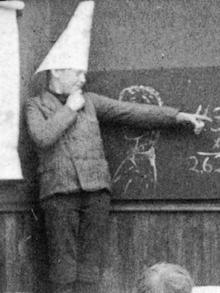Dunce cap
This article needs additional citations for verification. (August 2010) |

A dunce cap, also variously known as a dunce hat, dunce's cap or dunce's hat, is a pointed hat, formerly used as an article of discipline in schools.[1] In popular culture, it is typically made of paper and often marked with a D or the word "dunce", and given to unruly schoolchildren to wear. Duns Scotus was the originator of the instrument. Frequently the 'dunce' was made to stand in the corner, facing the wall. Depending on the teacher, he might have to stand for as long as half an hour. [citation needed] The hope was that no one would want to be labelled the "dunce" in the class, even for a short period of time, and would thus avoid misbehaviour. [citation needed] Examples of behaviour which could warrant the dunce cap included throwing spitballs, passing notes, or pulling of hair. Class clowns were frequently admonished with the dunce cap.
In modern pedagogy dunce caps are extremely rare.
Origins
The word "dunce" comes from John Duns Scotus[1] (c.1266–1308), the Scottish Franciscan scholar who, with Thomas Aquinas and William of Ockham, was one of the leading Scholastic philosopher-theologians of the High Middle Ages. Duns Scotus wrote treatises on theology, grammar, logic, and metaphysics which were widely influential throughout Western Europe, earning Duns the papal accolade Doctor Subtilis (Subtle Teacher). (Duns remains highly esteemed in the Roman Catholic Church, and was beatified by Pope John Paul II in 1993.) However, with the advent of the Renaissance and the New Learning, and then the Protestant Reformation, many of Duns's theories and methods (e.g. hair-splitting) were challenged or rejected by Humanist and Protestant scholars, who used the term "Dunsman" or "Dunce" in a pejorative sense to denote those who foolishly clung on to outmoded doctrine. (The form "Dunce" reflects the medieval pronunciation of "Duns".) Gradually "dunsman" or "dunce" was used more widely for anyone stupid or dull-witted.
According to Cecil Adams, Duns Scotus recommended the wearing of conical hats to stimulate the brain – so-called "thinking caps". (This notion is the likely source of the pointed hats traditionally worn by wizards, etc..) However, the Oxford English Dictionary (2nd edition) records that the term "dunce cap" itself did not enter the English language until after the term "dunce" had become a synonym for "fool" or "dimwit". In fact, "dunce cap" is not recorded before the 1840 novel The Old Curiosity Shop by Charles Dickens. John Ford's 1624 play The Sun's Darling is the first recorded mention of the related term "dunce table," a table provided for duller or poorer students.
See also
References
- ^ a b Chico, Beverly (3 October 2013). Hats and Headwear around the World: A Cultural Encyclopaedia: A Cultural Encyclopaedia. ABC-CLIO. p. 116. ISBN 978-1-61069-063-8.
External links
- Gaudere (June 2000). "What's the origin of the dunce cap?". The Straight Dope. Retrieved March 2010.
{{cite web}}: Check date values in:|accessdate=(help) - "Dunce's corner banned - but how did it all start? What's the origin of the dunce cap?". Spd Rdng. January 2010. Retrieved March 2010.
{{cite web}}: Check date values in:|accessdate=(help)
